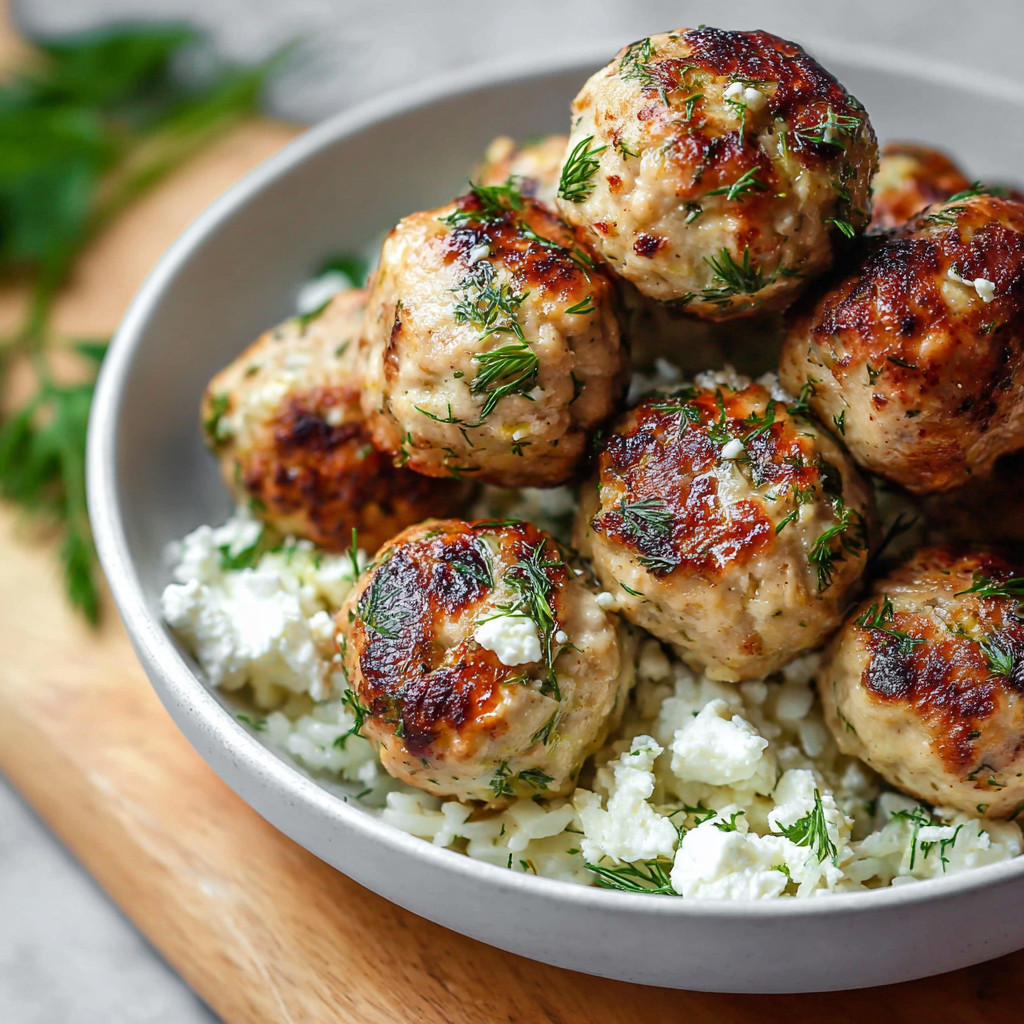 Save
Save
These Greek chicken meatballs are tender and bursting with the bright flavors of fresh herbs and creamy feta cheese. They make for a quick and easy weeknight dinner that can be cooked on the stovetop or baked in the oven. Perfectly versatile, you can serve them alongside rice and Greek roast potatoes, enjoy them in a fresh Greek salad, or tuck them into a pita or naan bread for a flavorful wrap.
I first made these meatballs on a busy weeknight and they came together so smoothly that they quickly became a family favorite. The fresh herbs bring out a wonderful brightness that really elevates these from ordinary meatballs.
Ingredients
- Ground chicken: which provides a lean protein base that stays moist
- Feta cheese: for a tangy and salty bite, choose a good quality block cheese for the best flavor
- Fresh dill and parsley: add aromatic freshness and vibrant color, look for bright green sprigs without wilting
- Dried oregano: brings traditional Greek earthiness and depth to the mix
- Garlic cloves: provide a punch of flavor, use fresh garlic and mince finely to avoid large chunks
- Breadcrumbs: help bind everything together and give structure, opt for plain breadcrumbs or panko for extra texture
- Egg: acts as a natural binder to keep the meatballs from falling apart
- Milk: moistens the breadcrumbs to ensure tender meatballs
- Salt and pepper: to season perfectly, fresh ground black pepper works best for a bite
- Extra virgin olive oil: for frying if you choose the stovetop method
Step-by-Step Instructions
- Ingredient Preparation:
- Finely chop fresh dill and parsley so that the herbs are evenly distributed throughout the mixture and release their flavor. Crumble the feta cheese into small pieces so it incorporates smoothly without large chunks. Mince the garlic cloves finely to avoid overpowering bites and to infuse the meatballs with even garlic flavor.
- Mixing the Ingredients:
- In a large bowl, combine ground chicken, chopped herbs, crumbled feta, minced garlic, breadcrumbs, egg, milk, dried oregano, salt, and pepper. Gently mix until just combined. Avoid overmixing because that can make the meatballs tough. The goal is a tender, airy texture that cooks evenly.
- Forming the Meatballs:
- Shape the mixture into uniform balls roughly 1 to 1.5 inches in diameter. Keeping the size even is key so the meatballs cook at the same rate whether you bake or fry them. I like to use a cookie scoop for consistent size and ease.
- For Baking:
- Preheat the oven to 400 degrees Fahrenheit (200 degrees Celsius). Line a baking sheet and space the meatballs evenly without crowding so the heat circulates well. Bake for 20 to 25 minutes until golden brown and cooked through to an internal temperature of 165 degrees Fahrenheit (74 degrees Celsius).
- For Frying:
- Heat a skillet over medium heat and add a thin layer of olive oil. Fry the meatballs in batches, turning occasionally to brown evenly on all sides. Cook until the internal temperature reaches the safe 165 degrees Fahrenheit and the exterior forms a nice crust.
 Save
Save
I love the fresh dill in these meatballs — it brings a bright, almost citrusy note that balances the creamy feta perfectly. One family dinner stands out where my kids insisted we make a double batch because they wanted leftovers for lunch the next day.
Storage Tips
Store leftover meatballs in an airtight container in the refrigerator for up to three days. For longer storage, freeze them on a baking sheet first so they remain separate, then transfer to a freezer-safe bag or container. Freeze for up to three months. Reheat in the oven at 350 degrees Fahrenheit or on the stovetop until warmed through.
Ingredient Substitutions
You can swap regular breadcrumbs for gluten-free versions to make this recipe gluten free. Omit the feta or use a dairy-free cheese alternative if you need a dairy-free option. Try mint instead of dill and parsley for a refreshing herbal twist. Baking rather than frying cuts down on added fat.
Serving Suggestions
Serve these meatballs with lemony Greek salad and tzatziki for a light meal, or alongside roasted potatoes and rice for a comforting dinner. They also work beautifully tucked inside pita or naan bread with sliced cucumber, tomatoes, and a drizzle of yogurt sauce or hummus for a Mediterranean-inspired wrap.
Cultural Context
Meatballs are a staple in Greek cuisine often enjoyed as part of meze platters or as a main dish with fresh herbs and cheese. The combination of garlic, oregano, and feta is a classic flavor profile found across many traditional Greek recipes, highlighting the Mediterranean love for simple but bold ingredients.
Pro Tips
- Make sure not to overmix the meatball mixture to keep them tender instead of dense
- Chill the formed meatballs in the fridge for about 30 minutes before cooking to help them hold their shape perfectly
- Do a test cook with a small portion of the mixture so you can adjust seasoning before making all of the meatballs
Common Recipe Questions
- → What herbs give these meatballs their Greek flavor?
Fresh dill, parsley, and dried oregano combine to create the signature herbaceous and aromatic profile typical of Greek dishes.
- → Can these meatballs be baked as well as fried?
Yes, they cook beautifully both baked at 400°F for 20-25 minutes or pan-fried with olive oil for a crisp exterior.
- → How does feta affect the meatballs?
Feta adds a salty, tangy creaminess that balances the herbs and adds a luscious texture inside the meatballs.
- → What is the best way to keep meatballs tender?
Mix ingredients gently without overworking and include milk-soaked breadcrumbs for moisture, which results in a tender texture.
- → Are there good substitutions for the breadcrumbs?
Gluten-free breadcrumbs or crushed gluten-free crackers work well to keep the mixture binding without gluten.
- → Can the herbs be swapped for others?
Yes, mint can be used instead of dill and parsley to give a different but still fresh Mediterranean flair.
